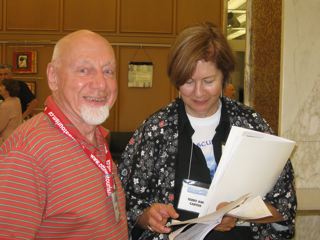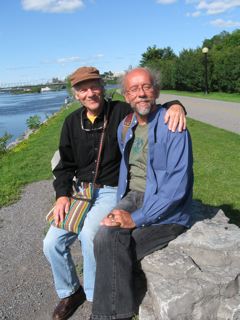
Just before the close of the conference, people gathered to share their memories of Bill Higginson and to read his words with our breath. It was cozy with the circle of people.
I couldn’t record verbatim each thing said but I hope to convey some of what was remembered reconstructed from notes. (I missed some people but add to the comments freely.)
John Stevenson and Michael Dylan Welch gave some overviews of his impact…
Higginson is on par with Harold Henderson or RH Blythe. He continued working his poems even though he had reached a level of being a father to the haiku community. The path he was on has since become a road and may soon become a highway and he was a part of that development.
Bill Higginson came to each HNA conference. He was the plenary speaker at the first one. His subject was addressing democracy in the haiku community. He was not content to preach to the choir but he evangelized for haiku. His reach was far. He wrote Wind in the Long Grass, a book on haiku for children and with Penny did Haiku Handbook among others. Penny mentioned that the publisher will put out a 25th anniversary edition of the handbook.
George Swede said that he was a larger than life figure and there might be more than one reason for that. For a time they both were in Japan and where ever Higginson went, he was greeted with Higginson-san and wherever Swede went he too was greeted Higginson-san. [They do bear passing resemblance.]
Margaret Chula said the foreward that Higginson made for her tanka book, Always Filling, Always Full demonstrated the kind of man he was in two ways. First, that it was written over Thanksgiving. What committment. And second in it he states he was re-reading an 8th century Japanese book. What scholarship!
Jerome Cushman remembered when Higginson was asked to judge a deaf student’s haiku contest. The previous judge wrote off all the submissions as undistinguished whereas in Higginson’s typical manner, Bill took the time to carefully read all and declared a winner in Sam Seppa’s poem
hide and seek
in the cornfield
first kiss
Nick Avis also spoke of the personable way Higginson had of seeing individuals and being present with who he was present with. His poem to Bill
his eyes
the way they held me
in the moment
Paul MacNeil was stuck by how, although he is a man younger in haiku than Higginson, he was given the respect of a colleague.
 Gary Hotham goes way back with Bill. When Gary was young he put an ad out in the New York classifieds to start a poetry journal. He got a response from Bill asking, do you know what you’re getting yourself in for?
Gary Hotham goes way back with Bill. When Gary was young he put an ad out in the New York classifieds to start a poetry journal. He got a response from Bill asking, do you know what you’re getting yourself in for?
 Charlie brought forward how Bill was in the habit of answering quickly and thoroughly. He stayed accessible and was happy to dialogue. Even now when he writes, Bill is internalized and he asks himself what Bill would think of a particular piece.
Charlie brought forward how Bill was in the habit of answering quickly and thoroughly. He stayed accessible and was happy to dialogue. Even now when he writes, Bill is internalized and he asks himself what Bill would think of a particular piece.
Micheline Beaudry shared a response Bill gave when he spoke to her group in Quebec City on whether haiku can be freestyle or should be constrained by rules. He said that any writer or group of writers may do anything. The issue is what’s the relationship between what they do it and what they call it. Is it a name that other people use for something else. Linked poetry takes a lifetime to do well. It keeps me alive to learn more. Although sometimes I wish people would learn more before they leap in we should encourage strengths rather than carp on failures.
David Burleigh related an ancecdote of when Bill visited him and repossessed a copy of the Haiku handbook. (Ask him to tell it if you get a chance.) He also shared a haiku about Bill written by a Romanian writer recently.
Lenard Moore is another person who has known Bill for years. In memory of him, this haiku was shared
night rain
the poet’s last email
still in my inbox
Dina Cox pointed out the striking level of being seen and feeling that what you say is important and heard. After her presentation he took the time to speak to her and looked her in the eye and shook her hand with a real handshake. Faye Aoyagi also mentioned that habit of his, for crisp attention and listening. {That nature of being a gentleman and genteel struck me as well.]
 Anita Krumins mentioned that although Bill could be stern and intransient, and Penny moderated that, he also was one of the most protective husbands she’s ever seen and told a story of Penny being dressed in a kimono with a few assistants. You’ll have to ask her for that story. She told it well.
Anita Krumins mentioned that although Bill could be stern and intransient, and Penny moderated that, he also was one of the most protective husbands she’s ever seen and told a story of Penny being dressed in a kimono with a few assistants. You’ll have to ask her for that story. She told it well.
Garry Gary described how powerful of pair the two were, the Bill and Penny show and shared,
autumn rain
the lamplight falls
on his sajiki
Kris moon kondo spoke of how Bill had a masterful but quiet presence. Once when they missed a flight, Bill got them on the next flight without a wait and with an upgrade to first class. It was characteristic of how he conducted himself with a belief that good will happen and the universe will open and it did.
Terry Ann Carter related a story of performing with Bill, Penny and John Stevenson, where there were dancers responding to spontaneously generated renku and how much at ease she was put and how at ease he was.
Naia spoke of how she felt she had missed the chance to really get to know Bill when she met him but is glad for this evening when she gets a chance to understand better who she met briefly one conference.
Patricia Donegan who knew Bill and Al Ginsberg related the haiku Bill wrote for Al.
Alan sick
no, gone
but still apricots bloom
Angelee Deodhar related how when she was in India in the days before email and internet, she came across this poetry form and write to Bill for instruction on what it was all about. In his habit of generosity and long reply, he answered not only with a letter this time but with 3 books.
Penny replied that Bill was generous because he knew he could answer and because he received so much by giving.
A few people mentioned how Bill gave a respect to each poem and poet. When asked to judge a contest he would not skim the entries but give consideration to each, set each aside and look again at another time of day to weigh it. He was impatient with sloppy logic and sloppy writing but eager to uphold a person as being worthy of being nurtured.
DeVar Dahl said what impressed him about both Penny and Bill was how they stayed involved in the community and in learning. Some speakers to conferences fly in, do their bit and leave whereas the couple came and didn’t even have presentations to make and attended as much as they could. Claudia Coutu Radmore added that the same had struck her. The small Kado group invited Bill and Penny to come and they not only came to a summer picnic reading but did a bookstore reading and added their haiku as anyone else to the broadsheet not expecting special treatment.
Someone read one of Bill’s haiku
restless pigeon
gentle words from clerk
bring tears
Guy Simser relayed the poem for Bill of
the clock
chimes and chimes and stops
but the river
Penny read a new poem to his memory, and the last haibun that Bill composed hours before he passed as well as told of her dream and her tribute haibun to Bill in which she feels Bill urged her — and would want us all– to bloom, bloom.

















 John Brandi and Dennis Maloney
John Brandi and Dennis Maloney
